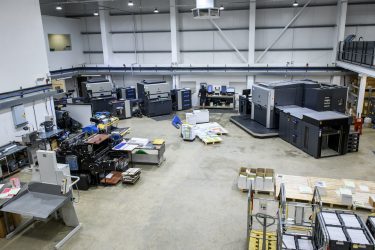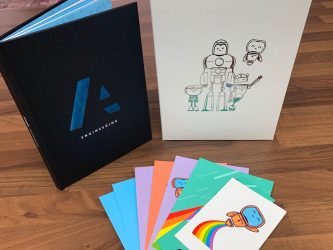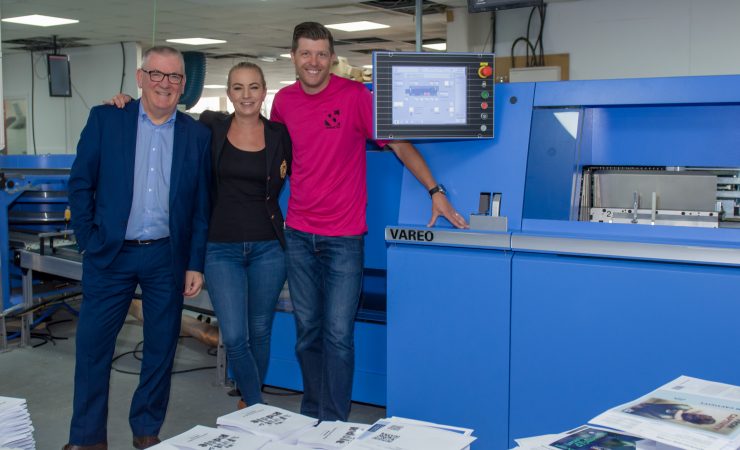Books and booklets are just as much an option for the non-specialist digital printer as they are for the dedicated book-of-one factories. Michael Walker visited some to see what they use
Books are one of the first things that come to mind for people outside the industry when they’re asked to name something that’s printed, and while huge numbers are still printed using offset, digital print is steadily gaining a foothold, making shorter runs and more responsive publishing possible, including opening up whole new sectors that wouldn’t be viable with conventional printing models.
One pioneer of this is Peterborough-based Bonacia, a digital-only printer whose output is ‘99.9% books’ according to managing director Rosie Whitelock. The colour print, which accounts for half the business by value, though only a quarter by volume, is produced on two Kodak Nexpress machines, while the mono work is handled by four Xerox Nuveras. Finishing duties are handled on a variety of equipment including a Horizon HT1000 three-knife trimmer and BQ470 four-clamp perfect binder and, most recently added, a Müller Martini Vareo perfect binder and Infinitrim three-knife trimmer, linked by a conveyor.
Production manager Carl Whitelock says the Müller kit was selected for its flexibility and ability to reset almost instantly for different spine thicknesses, plus faster first-book-out time; its ability to set itself via barcodes is something that Mr Whitelock plans to exploit too. Given that most of Bonacia’s book runs are in the low hundreds, though they have produced up to 8000 copies, these time savings add up. Mr Whitelock says that the company is now in the process of updating its own in-house developed MIS and workflow to reorientate them around the bindery, so that the size of the order, cover weight and book block size are all key parameters in scheduling work.

The production floor at Rapidity in Croydon
Book of some
Bonacia has made it its strategy to cater for short runs rather than chase ‘book of one’ work and has found a lucrative niche with business and lifestyle coaches and even pole dancing teachers who often write to books to complement their training courses. ‘The book is the new business card,’ says Mr Whitelock, while Ms Whitelock expands, ‘and they’re as cheap as chips at around £1.90 for a 17-page book printed in the low hundreds’.
The book sales can then help drive the marketing for the authors, who can have variable inserts promoting specific events or courses made and added to them, something that Amazon won’t do. Bonacia aims to provide a complete fulfilment service for this, and offers an automatic top-up when stocks fall below a pre-agreed level, printing and invoicing as required. The company’s website is designed to keep ordering simple for non-print specialists – making paper stock choice too complicated turned out to be a sales loser, for example.
Areas for further development include foiling and lamination but Mr Whitelock says the latter poses potential problems for workflow, with the need to switch between gloss and matt. The Müller equipment supports both larger and smaller formats that were previously possible, which opens up opportunities in A4 landscape books. Ms Whitelock summarises the company’s attitude to trying new things as, ‘We’re customer-led. If we’re asked five or more times for something, we’ll look at offering it to everyone.’
By comparison, books and booklets are one of many things produced at Sheffield and Stansted-based ProCo, which focuses mainly on direct mail. ‘We get do books by default for on-demand work,’ confirms CEO Jon Bailey, adding ‘we see the same trends here, volumes are down.’ This means short (from as little as one copy) to medium runs (hundreds of copies), and products like annual reports might have to be versioned with different sections for different audiences. Mr Bailey notes that items such as personalised children’s books, cookbooks and notebooks are in increasing demand. ‘Observe what’s happening, open up your mind,’ he advises.
While ProCo has Ryobi LED-UV litho presses, and work can be ganged for the larger formats using Metrix imposition and OneFlow workflow software, much of the short run book work is done on the company’s fleet of six HP Indigo presses. The SiteFlow element of HP’s PrintOS is used here; ‘there’s a large element of automation,’ says Mr Bailey. Book blocks are guillotined manually, however, then binding is carried out on a semi-automatic Horizon BQ270V perfect binder. The same finishing set-up is used at both the company’s sites, though a significant addition to the firm’s digital press fleet is anticipated imminently at Stansted, which may also expand its book printing capability.
Another all-digital print house is Rapidity, which expanded from its City of London site of the 30 years’ standing at the start of 2018 with the acquisition of Sidcup-based Lefa Print. The bulk of the digital print armoury is now located in Sidcup, comprising two Indigo 7900s and a B2 Indigo 12000, plus a Canon Océ Varioprint 6320 mono inkjet and a Ricoh Pro C9110 colour toner press. Display work is produced at the central London site on an Océ Arizona 2280XT flatbed and a Canon Colorado 1640 roll-fed UVgel printer and an HP Latex 360.

Samples of Rapidity’s work
Format flexibility
Managing director Paul Manning says that all the presses are used for book work according to availability but that as the products are mainly A sizes, the Indigo 7900s are the easiest to send SRA3 in one stack to the binder. He notes that the B2 Indigo, which has only been in operation since April 2019, opens up new formats and sizes such as A4 landscape and newspaper-sized publications. The Indigo 12000 isn’t fitted with HP’s HDNA ‘high definition’ capability but Mr Manning says the quality is already good enough for commercial work and indeed claims that having been through a variety of digital presses, the Indigos were the first where ‘we didn’t have to apologise for the quality’. White ink is used a lot on coloured or metallic substrates at Rapidity, and although pre-coating can be expensive, Mr Manning says it works for short run jobs.
Finishing is handled by a Duplo DBM 500T for booklets, a Duplo iSaddle Pro saddle stitcher, a Horizon BQ470 four-clamp perfect binder and a Morgana/Plockmatic Documaster square-back binder; trimming is done by guillotine. These are complemented by manual foil blocking and diecutting. Workflow is a combination of Enfocus Switch and a ‘religiously’ used Tharstern MIS, though interestingly Mr Manning says that while a decade ago, most of the company’s work could have been automated, today’s diversity of job types means that it can’t be and a key decision for the production system is whether is job is ‘standard’ or ‘bespoke’. ‘We have to pick our battles, to take away admin. A lot of work is manually handled because it has to be,’ says Mr Manning.





